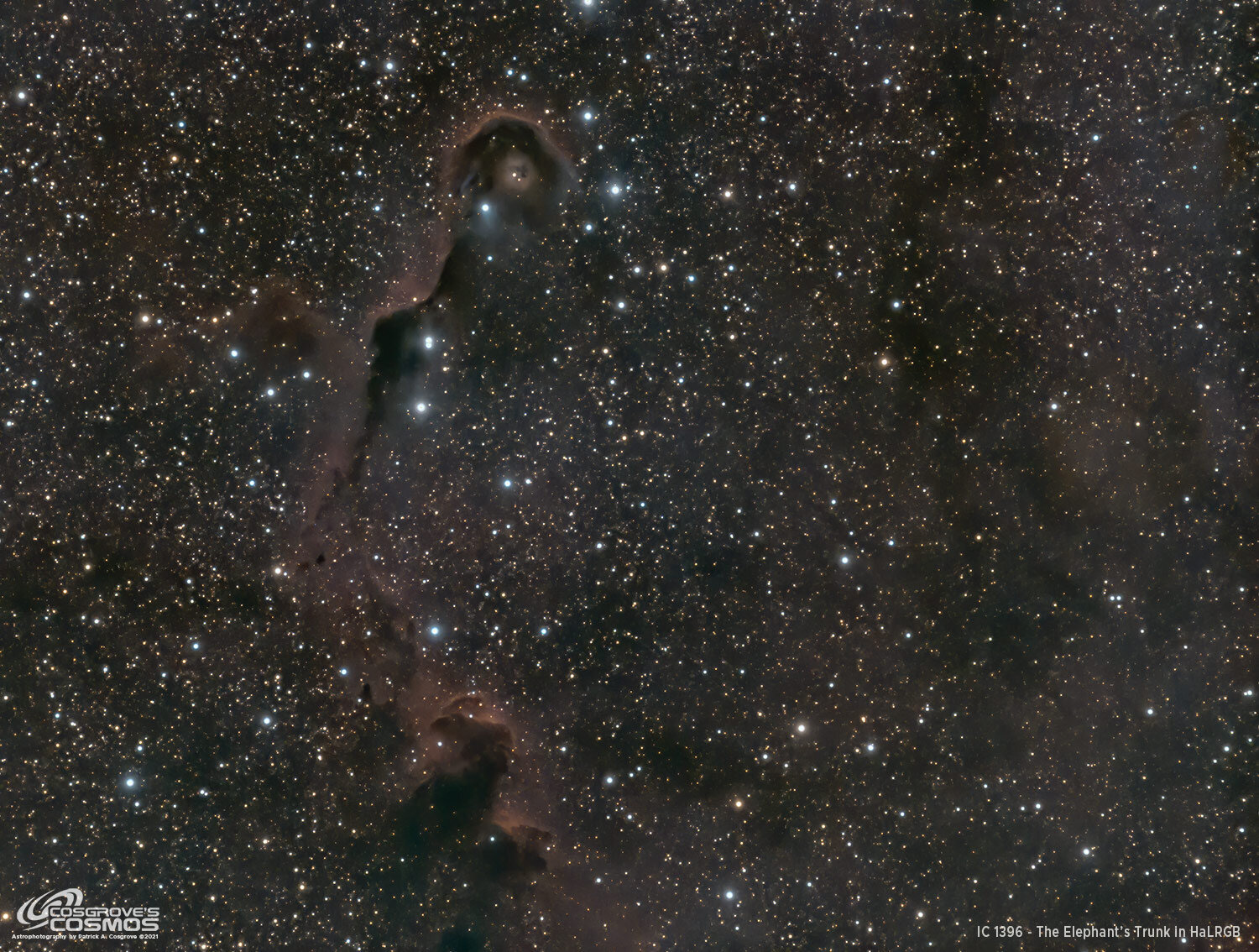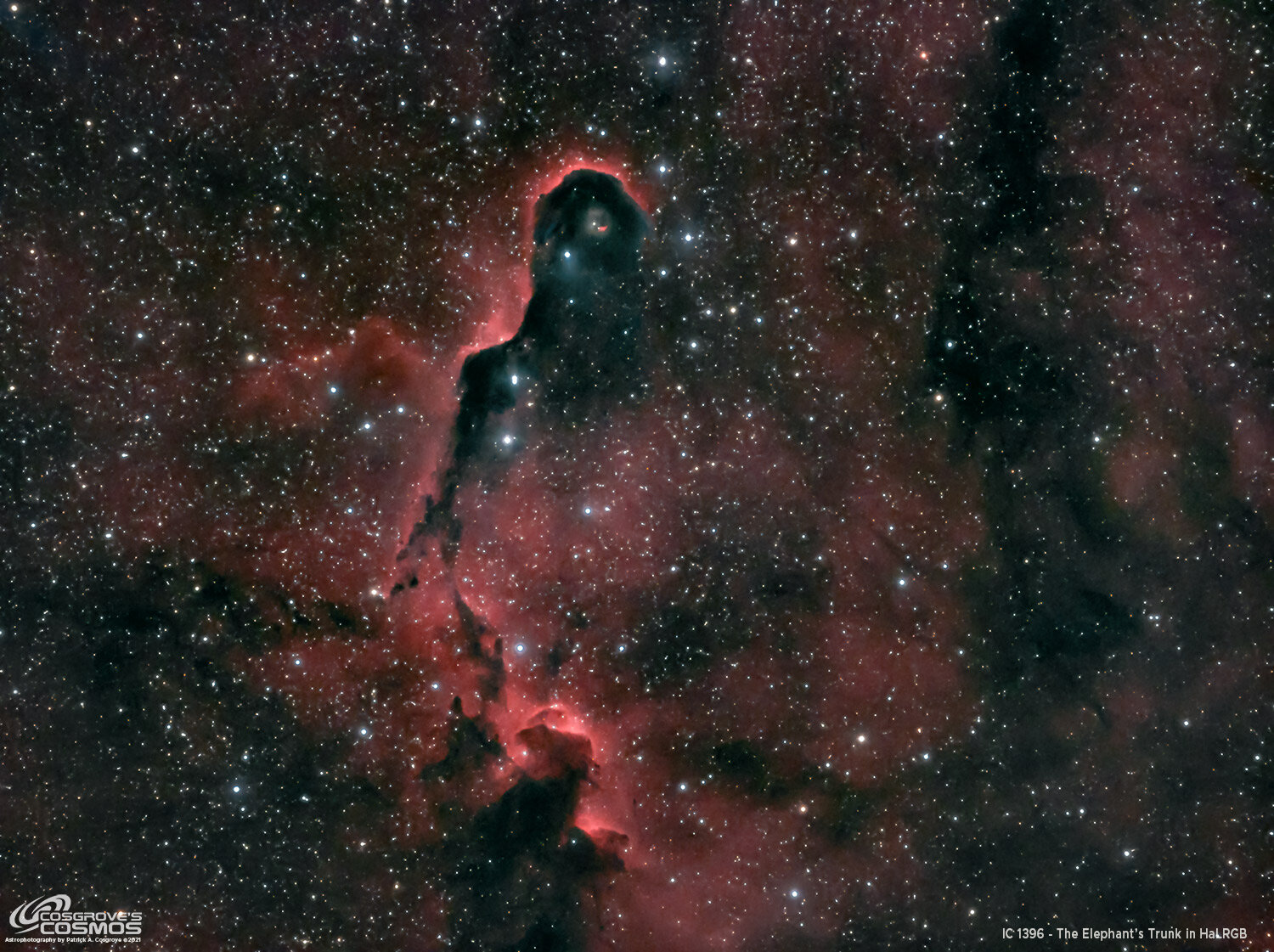IC 1396 - The Elephant’s Trunk - Now with Added Ha
Date: July 26, 2020
Cosgrove’s Cosmos Catalog ➤#0045
IC 1396 - The Elephant’s Trunk after Ha data was added to the LRGB. (click to enlarge)
Table of Contents Show (Click on lines to navigate)
About the Target
IC1396 - The Elephant's Trunk Nebula. Located about 2400 light-years from Earth, in the constellation of Cepheus, IC1396 is a bright region of gas and dust. This area is rich in star formation, with over 10K newly formed blue stars. The prominent dust feature rimmed with glowing emission light is called the Elephant's Trunk Nebula and is designated IC1396A.
The Annotated Image
For some reason, Pixinsight’s ImageSolver was not able to platesolve this image so I could not create my annotated image in the normal fashion. So I ended up doing a screen grab of the image from my Astrobin account. Thanks Astrobin - a truly great resource for Astrophotographers.
The Location in the Sky
IAU/Sky & Telescope Constellation Chart for Cepheus, showing IC1396’s location indicated by a yellow arrow.
About the Project
A few days ago I shared an image of IC1396, also known as the Elephants trunk. It was one of my very first LRGB images after doing a year of One-Shot-Color Camera work.
I went back a couple of nights later and collected my first narrowband data for this object. I captured 10x6minute exposures at an elevated camera gain of 200. Then I processed that image and combined it with my previous LRGB data. Since my Ha was a 7nm band slice of the red region - I would have expected that it would greatly increase red saturation and detail - and it did just that. I had to lay around with various methods of adding the Ha data, what I ended up doing was using PixelMath to add the Ha data to the red image with a weighting function on the Ha. I experimented until I got a mix that I thought looked good, and then finished processing the image.
I am very new to mono work and LRGB and narrowband workflows and I do find them to require a lot more work and effort. So why do it? Because the results can be magical. I thought my first version of this image looked pretty good - but I love these results with the added Ha data!
I think I am hooked on this whole mono LRGB/Narrowband thing!
Here is a link to my previous image: IC 1396 in LRGB
Comparing the Two Images
In LRGB…
With added Ha - what a great improvement!
Capture Details
Light Frames
20 x 120 seconds Lum
10 x 120 seconds R
10 x 120 seconds G
10 x 120 seconds B
10 x 360 seconds Ha
Total of 2.66 hours
7-28-21 note: I was so new at this at the time, I never recorded little details like camera binning or cooldown temps!
Cal Frames
100 x 2 second Bias exposures
50 x 120 second Dark exposures
50 x 360 second Dark exposures
100 Lum Flats
100 R Flats
100 G Flats
100 B Flats
100 Ha Flats
Capture Hardware
Scope: Astrophysics 130mm Starfire F/8.35 APO refractor
Guide Scope: Televue 76mm Doublet
Camera: ZWO ASI1600mm-pro with ZWO Filter wheel with ZWO LRGB filter set, and ZWO GeII 7nm Narrowband filter set
Guide Camera: ZWO ASI290Mini
Focus Motor: Pegasus Astro Focus Cube 2
Mount: Ioptron CEM60
Polar Alignment: Polemaster camera
Software
Capture Software: PHD2 Guider, Sequence Generator Pro controller
Image Processing: Pixinsight, Photoshop - assisted by Coffee, extensive processing indecision and second-guessing, editor regret and much swearing…..



Over the winter, I began to get things ready for the second platform. Clearly I had some work to do. I needed to determine what I was going to do for a camera, and I needed to determine what to do get the mount functioning at the precision needed.